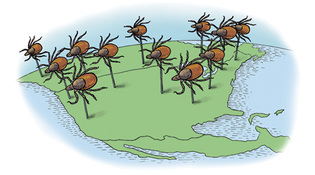 loading
loading
FindingsYes, the west coast should worry about ticksSamples from northern California show the presence of a Lyme-like disease.  Gregory NemecView full imageSome 30 years ago, medical researchers took blood serum samples from 101 residents of northern California, tested the samples for Lyme disease, and then froze them. Now scientists at Yale and the University of California have checked these biological time capsules for signs of a different tick-borne disease. The news isn’t good. The 101 serum samples all came from a rural area dense with ticks, and in 1990 some tested positive for Lyme. The new tests looked for signs of a related bacterium, Borrelia miyamotoi. It can cause symptoms similar to Lyme disease: fever, chills, headaches, joint pain, and fatigue, among others. The disease is still relatively new to science, says Erol Fikrig, chief of the Infectious Diseases Section at Yale School of Medicine and one of the study’s authors, so “we don’t yet know its full range of symptoms.” About two dozen of the 30-year-old samples tested positive for antibodies to B. miyamotoi, showing that the individuals had been exposed to the bacterium. Cases of B. miyamotoi have been known in the northeastern and midwestern United States for some time—but these are the first human cases found in the west. (The study appeared in the journal PLOS One.) Like Lyme, B. miyamotoi is hard to identify. The study’s authors note that their evidence is strong but not definitive; other tick-borne pathogens may be muddying the results and the test itself may not be 100 percent reliable. The most important point, Fikrig warns, is that “tick-borne diseases are not confined by geographic area.”
The comment period has expired.
|
|